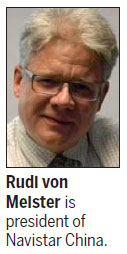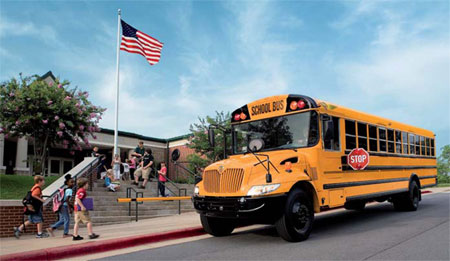Relief from heavy load of worries
Updated: 2012-10-19 08:37
By Wang Chao (China Daily)
|
||||||||
|
Buses made by Navistar are widely used as school buses in the United States. Provided to China Daily |

US giant looks to China to make up for woes at home
'When the going gets tough, the tough get going," says an aphorism often ascribed to the late Joseph Kennedy, father of the late American president John F. Kennedy. Amid global gloom in the commercial vehicle industry, the US' oldest truck and bus maker, Navistar International Corp, seems to have taken that old saying to heart, picking up its bags and coming to China as it seeks to make up for its flagging domestic fortunes.
It has formed an engine joint venture with Jianghuai Automobile Co of Anhui province and is again clocking up miles on a roadtrip in China that began more than 60 years ago.
Navistar, with roots that go back to Chicago in 1902, has its headquarters in Lisle, Illinois, and had revenue of $14 billion (11 billion euros) last year. It also sells chassis and engines.
JAC is a commercial vehicle manufacturer whose products include buses, heavy-duty trucks and light trucks, and its turnover was 30.47 billion yuan last year.
Related reading:
Report hurts long-term trade prospects
Reeling at home under the pressures of a grim US economy, Navistar's net income there fell from $1.4 billion in the third quarter of last year to $84 million this year, according to the company's results.
In contrast, Navistar's turnover outside the US was $3.5 billion last year; a $2 billion rise on the previous year. The company says it expects that turnover to rise to $12 billion by 2015, similar to its North American turnover.
Against that backdrop, Navistar is now giving much more attention to China, whose government approved the engine joint venture with JAC in July. The deal was signed on Aug 23.
The company, which boasts that "we've helped drive economies forward", has begun to gain prominent coverage in the Chinese media only recently, but its ties with the country go back decades. A truck that appears on the 1953 version of China's one-cent note is said to have been adapted from Navistar's K-series trucks.
A total of 1.8 billion yuan is being poured into the engine joint venture, and a factory is now being built. It is due to open next year and is expected to produce 150,000 vehicles a year, says Leo Lu, general manager of Navistar China.
Rudi von Meister, president of Navistar China, says what Navistar can offer in this partnership is the vision of a global market and cutting-edge technology, "while JAC can teach us how to reduce costs, so we can compete in this cost-sensitive market".
Before joining Navistar last year Von Meister worked for General Motors for more than 20 years and helped to set up its automotive joint venture with SAIC and GM's Delphi automotive systems business unit. In 2006 he joined Fiat Group as general manager of China operations for the Iveco commercial vehicle division and vice-president of business development at Fiat China.
Although Navistar has sold trucks through dealers in China for years, "the idea that we come as a truck maker really emerged when the engine localization became a reality", Von Meister says.
Navistar first licensed its engine to Dongfeng Chaoyang Diesel Co, a JAC engine supplier, and then hooked up with JAC.
The joint-venture products will incorporate Navistar MaxxForce engines as well as its suspension and braking systems, Von Meister says. For buses, bodies will be imported from the US, "with some adaptation to the Chinese industry standards".
Navistar now has 48 percent of the school-bus market in North America, the company says. There has been a spate of serious school-bus accidents in China in the past year, and the government has tightened safety requirements, providing an opening for Western school-bus manufacturers.
Asked about the buses, Von Meister says: "We came not to make the Rolls-Royce-level bus in China, because the market doesn't want it; if the market wants a Chevrolet-level bus we will do it."
With the buses, the company has been working closely with Chinese industry safety experts since last year, he says.
Although the company says joint-venture vehicles will include medium-sized and heavy-duty trucks, the models are yet to be decided. "We don't make light trucks, but that doesn't mean we cannot help our partners," Von Meister says.
The Chinese market heavily favors cab-over-engine trucks, he says, a formula introduced by European and Japanese truck makers, which Von Meister says is appropriate to many Chinese cities with narrow roads, but which are less aerodynamic and fuel-efficient than cab-behind-engine models.
The cab-behind-engine trucks, often called long-nose trucks, are reckoned to be up to 15 percent more efficient than cab-over-engine models. The joint venture will consider bringing the long-nose, which is prevalent in developed countries, to China.
Apart from tapping the domestic market, the joint venture also shares a common mission to explore the world market.
An Jin, president of JAC, says the joint venture will explore the overseas market.
Von Meister says that when one market falls "there are other markets going up, so our business is more stable by not being too exposed to a single market".
With the prolonged downturn, China may be a better market than the US or European markets, but three years of bullish growth appear to have ended.
wangchao@chinadaily.com.cn
(China Daily 10/19/2012 page11)

 Relief reaches isolated village
Relief reaches isolated village
 Rainfall poses new threats to quake-hit region
Rainfall poses new threats to quake-hit region
 Funerals begin for Boston bombing victims
Funerals begin for Boston bombing victims
 Quake takeaway from China's Air Force
Quake takeaway from China's Air Force
 Obama celebrates young inventors at science fair
Obama celebrates young inventors at science fair
 Earth Day marked around the world
Earth Day marked around the world
 Volunteer team helping students find sense of normalcy
Volunteer team helping students find sense of normalcy
 Ethnic groups quick to join rescue efforts
Ethnic groups quick to join rescue efforts
Most Viewed
Editor's Picks

|

|

|

|

|

|
Today's Top News
Chinese fleet drives out Japan's boats from Diaoyu
Health new priority for quake zone
Inspired by Guan, more Chinese pick up golf
Russia criticizes US reports on human rights
China, ROK criticize visits to shrine
Sino-US shared interests emphasized
China 'aims to share its dream with world'
Chinese president appoints 5 new ambassadors
US Weekly

|

|








